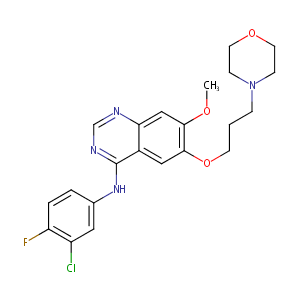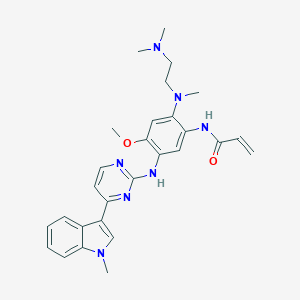| DOT Name |
DOT ID |
UniProt ID |
Mode of Action |
REF |
|
Broad substrate specificity ATP-binding cassette transporter ABCG2 (ABCG2)
|
OTW8V2V1
|
ABCG2_HUMAN
|
Increases ADR
|
[17] |
|
Epidermal growth factor receptor (EGFR)
|
OTAPLO1S
|
EGFR_HUMAN
|
Decreases Response To Substance
|
[18] |
|
Sulfhydryl oxidase 1 (QSOX1)
|
OT4ZPK4P
|
QSOX1_HUMAN
|
Increases Expression
|
[19] |
|
Growth arrest and DNA damage-inducible protein GADD45 gamma (GADD45G)
|
OT8V1J4M
|
GA45G_HUMAN
|
Decreases Expression
|
[19] |
|
Interferon alpha-inducible protein 6 (IFI6)
|
OTWOOAM4
|
IFI6_HUMAN
|
Decreases Expression
|
[19] |
|
Fibroblast growth factor 6 (FGF6)
|
OTRJ679P
|
FGF6_HUMAN
|
Increases Expression
|
[19] |
|
Ski oncogene (SKI)
|
OT4KJ8F6
|
SKI_HUMAN
|
Increases Expression
|
[19] |
|
Erythropoietin receptor (EPOR)
|
OTUIOEU3
|
EPOR_HUMAN
|
Increases Expression
|
[19] |
|
Nuclear factor NF-kappa-B p105 subunit (NFKB1)
|
OTNRRD8I
|
NFKB1_HUMAN
|
Decreases Expression
|
[19] |
|
Tumor necrosis factor receptor superfamily member 1B (TNFRSF1B)
|
OTDS2EAR
|
TNR1B_HUMAN
|
Decreases Expression
|
[19] |
|
Growth arrest and DNA damage-inducible protein GADD45 alpha (GADD45A)
|
OTDRV63V
|
GA45A_HUMAN
|
Increases Expression
|
[19] |
|
Cytochrome P450 2F1 (CYP2F1)
|
OTY3HJH1
|
CP2F1_HUMAN
|
Decreases Expression
|
[19] |
|
Replication protein A 70 kDa DNA-binding subunit (RPA1)
|
OT76POLP
|
RFA1_HUMAN
|
Increases Expression
|
[19] |
|
Adenosine receptor A1 (ADORA1)
|
OTI7X39E
|
AA1R_HUMAN
|
Decreases Expression
|
[19] |
|
14-3-3 protein sigma (SFN)
|
OTLJCZ1U
|
1433S_HUMAN
|
Decreases Expression
|
[19] |
|
DNA mismatch repair protein Mlh1 (MLH1)
|
OTG5XDD8
|
MLH1_HUMAN
|
Decreases Expression
|
[19] |
|
Glycine--tRNA ligase (GARS1)
|
OT5B6R9Y
|
GARS_HUMAN
|
Increases Expression
|
[19] |
|
Epidermal growth factor receptor substrate 15 (EPS15)
|
OT7NPP8U
|
EPS15_HUMAN
|
Increases Expression
|
[19] |
|
Neuronal pentraxin-2 (NPTX2)
|
OT3SSJDP
|
NPTX2_HUMAN
|
Decreases Expression
|
[19] |
|
Leptin receptor (LEPR)
|
OT9H7G0C
|
LEPR_HUMAN
|
Decreases Expression
|
[19] |
|
Neural retina-specific leucine zipper protein (NRL)
|
OT65MFKQ
|
NRL_HUMAN
|
Decreases Expression
|
[19] |
|
Guanine nucleotide-binding protein G(I)/G(S)/G(T) subunit beta-2 (GNB2)
|
OT3JPRCQ
|
GBB2_HUMAN
|
Decreases Expression
|
[19] |
|
Retinal guanylyl cyclase 1 (GUCY2D)
|
OT81UJI0
|
GUC2D_HUMAN
|
Decreases Expression
|
[19] |
|
Cell growth regulator with RING finger domain protein 1 (CGRRF1)
|
OTLMNRCL
|
CGRF1_HUMAN
|
Increases Expression
|
[19] |
|
Dual specificity protein phosphatase 9 (DUSP9)
|
OTZZWEQL
|
DUS9_HUMAN
|
Decreases Expression
|
[19] |
|
Bile salt export pump (ABCB11)
|
OTRU7THO
|
ABCBB_HUMAN
|
Decreases Activity
|
[20] |
|
Retinoblastoma-associated protein (RB1)
|
OTQJUJMZ
|
RB_HUMAN
|
Decreases Expression
|
[21] |
|
Glycogen synthase kinase-3 beta (GSK3B)
|
OTL3L14B
|
GSK3B_HUMAN
|
Decreases Expression
|
[21] |
|
Cyclin-dependent kinase 6 (CDK6)
|
OTR95N0X
|
CDK6_HUMAN
|
Decreases Expression
|
[21] |
|
Telomerase reverse transcriptase (TERT)
|
OT085VVA
|
TERT_HUMAN
|
Decreases Expression
|
[22] |
|
Baculoviral IAP repeat-containing protein 5 (BIRC5)
|
OTILXZYL
|
BIRC5_HUMAN
|
Decreases Expression
|
[23] |
|
Ubiquitin-like modifier-activating enzyme ATG7 (ATG7)
|
OTVT4YA1
|
ATG7_HUMAN
|
Increases Expression
|
[24] |
|
Myc proto-oncogene protein (MYC)
|
OTPV5LUK
|
MYC_HUMAN
|
Decreases Expression
|
[25] |
|
Tumor necrosis factor (TNF)
|
OT4IE164
|
TNFA_HUMAN
|
Decreases Expression
|
[7] |
|
Interleukin-1 beta (IL1B)
|
OT0DWXXB
|
IL1B_HUMAN
|
Increases Expression
|
[26] |
|
HLA class II histocompatibility antigen, DRB1 beta chain (HLA-DRB1)
|
OTRGGIFP
|
DRB1_HUMAN
|
Affects Expression
|
[27] |
|
Estrogen receptor (ESR1)
|
OTKLU61J
|
ESR1_HUMAN
|
Decreases Phosphorylation
|
[28] |
|
Receptor tyrosine-protein kinase erbB-2 (ERBB2)
|
OTOAUNCK
|
ERBB2_HUMAN
|
Decreases Phosphorylation
|
[29] |
|
HLA class II histocompatibility antigen, DO alpha chain (HLA-DOA)
|
OTZE5Q7R
|
DOA_HUMAN
|
Affects Expression
|
[27] |
|
Heat shock protein HSP 90-alpha (HSP90AA1)
|
OTLG1WPK
|
HS90A_HUMAN
|
Increases Secretion
|
[26] |
|
Insulin-like growth factor 1 receptor (IGF1R)
|
OTXJIF13
|
IGF1R_HUMAN
|
Increases Phosphorylation
|
[30] |
|
High mobility group protein B1 (HMGB1)
|
OT4B7CPF
|
HMGB1_HUMAN
|
Increases Secretion
|
[26] |
|
Poly polymerase 1 (PARP1)
|
OT310QSG
|
PARP1_HUMAN
|
Increases Cleavage
|
[31] |
|
Heat shock 70 kDa protein 1A (HSPA1A)
|
OTKGIE76
|
HS71A_HUMAN
|
Increases Secretion
|
[26] |
|
C-C motif chemokine 2 (CCL2)
|
OTAD2HEL
|
CCL2_HUMAN
|
Increases Secretion
|
[32] |
|
Matrix metalloproteinase-9 (MMP9)
|
OTB2QDAV
|
MMP9_HUMAN
|
Decreases Expression
|
[7] |
|
Platelet endothelial cell adhesion molecule (PECAM1)
|
OTXOM4D9
|
PECA1_HUMAN
|
Decreases Expression
|
[7] |
|
Ribosomal protein S6 kinase beta-1 (RPS6KB1)
|
OTAELNGX
|
KS6B1_HUMAN
|
Decreases Phosphorylation
|
[24] |
|
Alanine aminotransferase 1 (GPT)
|
OTOXOA0Q
|
ALAT1_HUMAN
|
Increases Secretion
|
[33] |
|
G1/S-specific cyclin-D1 (CCND1)
|
OT8HPTKJ
|
CCND1_HUMAN
|
Decreases Expression
|
[18] |
|
DnaJ homolog subfamily B member 1 (DNAJB1)
|
OTCOSEVH
|
DNJB1_HUMAN
|
Increases Secretion
|
[26] |
|
Mitogen-activated protein kinase 3 (MAPK3)
|
OTCYKGKO
|
MK03_HUMAN
|
Decreases Expression
|
[34] |
|
Mitogen-activated protein kinase 1 (MAPK1)
|
OTH85PI5
|
MK01_HUMAN
|
Decreases Expression
|
[34] |
|
Caspase-1 (CASP1)
|
OTZ3YQFU
|
CASP1_HUMAN
|
Increases Activity
|
[26] |
|
G1/S-specific cyclin-D3 (CCND3)
|
OTNKPQ22
|
CCND3_HUMAN
|
Decreases Expression
|
[18] |
|
HLA class I histocompatibility antigen, alpha chain F (HLA-F)
|
OT76CM19
|
HLAF_HUMAN
|
Affects Expression
|
[27] |
|
RAC-alpha serine/threonine-protein kinase (AKT1)
|
OT8H2YY7
|
AKT1_HUMAN
|
Decreases Phosphorylation
|
[35] |
|
Cyclin-dependent kinase inhibitor 1 (CDKN1A)
|
OTQWHCZE
|
CDN1A_HUMAN
|
Decreases Expression
|
[23] |
|
Serine/threonine-protein kinase mTOR (MTOR)
|
OTHH8KU7
|
MTOR_HUMAN
|
Decreases Phosphorylation
|
[24] |
|
Cyclin-dependent kinase 4 inhibitor B (CDKN2B)
|
OTAG24N1
|
CDN2B_HUMAN
|
Increases Expression
|
[25] |
|
Mitogen-activated protein kinase 8 (MAPK8)
|
OTEREYS5
|
MK08_HUMAN
|
Decreases Phosphorylation
|
[7] |
|
Cyclin-dependent kinase inhibitor 1B (CDKN1B)
|
OTNY5LLZ
|
CDN1B_HUMAN
|
Increases Expression
|
[18] |
|
Tumor necrosis factor ligand superfamily member 6 (FASLG)
|
OTZARCHH
|
TNFL6_HUMAN
|
Increases Response To Substance
|
[36] |
|
Cytochrome c (CYCS)
|
OTBFALJD
|
CYC_HUMAN
|
Affects Localization
|
[31] |
|
Transcription factor E2F1 (E2F1)
|
OTLKYBBC
|
E2F1_HUMAN
|
Decreases Expression
|
[22] |
|
Caveolin-1 (CAV1)
|
OTEZUR1L
|
CAV1_HUMAN
|
Increases Expression
|
[34] |
|
Sequestosome-1 (SQSTM1)
|
OTGY5D5J
|
SQSTM_HUMAN
|
Decreases Expression
|
[37] |
|
Kelch-like ECH-associated protein 1 (KEAP1)
|
OTFHOD0C
|
KEAP1_HUMAN
|
Increases Expression
|
[38] |
|
Caspase-8 (CASP8)
|
OTA8TVI8
|
CASP8_HUMAN
|
Increases Cleavage
|
[36] |
|
Cytochrome P450 1B1 (CYP1B1)
|
OTYXFLSD
|
CP1B1_HUMAN
|
Decreases Activity
|
[39] |
|
MHC class I polypeptide-related sequence B (MICB)
|
OTS2DVDW
|
MICB_HUMAN
|
Increases Expression
|
[40] |
|
MHC class I polypeptide-related sequence A (MICA)
|
OTPEIEAR
|
MICA_HUMAN
|
Increases Expression
|
[40] |
|
Estrogen receptor beta (ESR2)
|
OTXNR2WQ
|
ESR2_HUMAN
|
Increases Expression
|
[41] |
|
Serine protease HTRA1 (HTRA1)
|
OTR8ACBF
|
HTRA1_HUMAN
|
Increases Expression
|
[42] |
|
Major histocompatibility complex class I-related gene protein (MR1)
|
OTZU3XX7
|
HMR1_HUMAN
|
Affects Expression
|
[27] |
|
Autophagy protein 5 (ATG5)
|
OT4T5SMS
|
ATG5_HUMAN
|
Increases Expression
|
[24] |
|
Transcription factor SOX-17 (SOX17)
|
OT9H4WWE
|
SOX17_HUMAN
|
Decreases Localization
|
[43] |
|
MARVEL domain-containing protein 1 (MARVELD1)
|
OT5CPOJE
|
MALD1_HUMAN
|
Decreases Response To Substance
|
[44] |
|
GTPase KRas (KRAS)
|
OT78QCN8
|
RASK_HUMAN
|
Decreases Response To Substance
|
[45] |
|
Zinc finger protein SNAI2 (SNAI2)
|
OT7Y8EJ2
|
SNAI2_HUMAN
|
Affects Response To Substance
|
[46] |
|
Membrane-associated progesterone receptor component 1 (PGRMC1)
|
OTBE6WAC
|
PGRC1_HUMAN
|
Decreases Response To Substance
|
[47] |
|
Cytochrome P450 1A1 (CYP1A1)
|
OTE4EFH8
|
CP1A1_HUMAN
|
Increases Response To Substance
|
[48] |
|
Glutamate--cysteine ligase catalytic subunit (GCLC)
|
OTESDI4D
|
GSH1_HUMAN
|
Affects Response To Substance
|
[49] |
|
RNA-binding protein 7 (RBM7)
|
OTFIWTMF
|
RBM7_HUMAN
|
Affects Response To Substance
|
[49] |
|
Cell death regulator Aven (AVEN)
|
OTGIN5YK
|
AVEN_HUMAN
|
Affects Response To Substance
|
[49] |
|
Forkhead box protein O3 (FOXO3)
|
OTHXQG4P
|
FOXO3_HUMAN
|
Increases Response To Substance
|
[50] |
|
Phospholipase B-like 1 (PLBD1)
|
OTHYEB4W
|
PLBL1_HUMAN
|
Affects Response To Substance
|
[49] |
|
Cellular tumor antigen p53 (TP53)
|
OTIE1VH3
|
P53_HUMAN
|
Affects Response To Substance
|
[51] |
|
Securin (PTTG1)
|
OTIMYS4W
|
PTTG1_HUMAN
|
Decreases Response To Substance
|
[31] |
|
Amphiregulin (AREG)
|
OTJFOR67
|
AREG_HUMAN
|
Decreases Response To Substance
|
[49] |
|
Pleckstrin homology-like domain family A member 2 (PHLDA2)
|
OTMV9DPP
|
PHLA2_HUMAN
|
Affects Response To Substance
|
[49] |
|
Aurora kinase A (AURKA)
|
OTMX0HYT
|
AURKA_HUMAN
|
Decreases Response To Substance
|
[51] |
|
DNA excision repair protein ERCC-1 (ERCC1)
|
OTNPYQHI
|
ERCC1_HUMAN
|
Affects Response To Substance
|
[10] |
|
Bcl-2-like protein 11 (BCL2L11)
|
OTNQQWFJ
|
B2L11_HUMAN
|
Increases Response To Substance
|
[52] |
|
Ceramide transfer protein (CERT1)
|
OTNUCNHX
|
CERT_HUMAN
|
Affects Response To Substance
|
[49] |
|
DNA repair protein RAD51 homolog 1 (RAD51)
|
OTNVWGC1
|
RAD51_HUMAN
|
Affects Response To Substance
|
[53] |
|
Oncostatin-M-specific receptor subunit beta (OSMR)
|
OTORWHPL
|
OSMR_HUMAN
|
Affects Response To Substance
|
[49] |
|
Protransforming growth factor alpha (TGFA)
|
OTPD1LL9
|
TGFA_HUMAN
|
Decreases Response To Substance
|
[54] |
|
Dual specificity protein phosphatase 3 (DUSP3)
|
OTPJX9B4
|
DUS3_HUMAN
|
Affects Response To Substance
|
[49] |
|
Transcription factor p65 (RELA)
|
OTUJP9CN
|
TF65_HUMAN
|
Decreases Response To Substance
|
[51] |
|
Pericentrin (PCNT)
|
OTW4Z65J
|
PCNT_HUMAN
|
Decreases Response To Substance
|
[47] |
|
Coronin-1C (CORO1C)
|
OTXDF9T3
|
COR1C_HUMAN
|
Affects Response To Substance
|
[49] |
|
Ribonucleoside-diphosphate reductase large subunit (RRM1)
|
OTXGQOR9
|
RIR1_HUMAN
|
Affects Response To Substance
|
[10] |
| ------------------------------------------------------------------------------------ |
|
|
|
|


